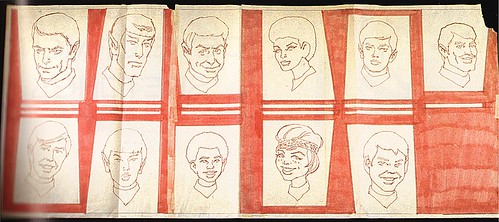“The Slaver Weapon” (Dec. 15, 1973)
Dorothy Fontana was a big fan of Larry Niven and when TAS was getting off the ground she invited him to submit a story. Subsequently Niven adapted one of his own original stories, “The Soft Weapon,” into one of TAS’ and Star Trek’s most interesting stories. And in it he introduces one of his creations, the ferocious and warlike Kzin into the Trek universe. In Trek they’re known as the Kzinti.
One of the truly interesting features of this episode is that only three of the familiar Enterprise crew are present throughout the story. Spock, Uhura and Sulu are aboard a shuttlecraft transporting an ancient artifact to a starbase when they are diverted to a small icy asteroid. Here they are taken captive by the large catlike Kzinti who are after the artifact Spock and company are transporting. It then becomes a struggle between the two parties vying to retain possession of the ancient artifact.
There is an interesting new shuttlecraft design introduced here, too.
There really isn’t much point to this story other than being an entertaining straight up adventure. If there is a point it’s too much curiosity can kill the cat, and it happens here, literally.
This is a story I would have absolutely loved to have seen as live-action given a way could be found to bring the Kzinti convincingly to life.
Dorothy Fontana was a big fan of Larry Niven and when TAS was getting off the ground she invited him to submit a story. Subsequently Niven adapted one of his own original stories, “The Soft Weapon,” into one of TAS’ and Star Trek’s most interesting stories. And in it he introduces one of his creations, the ferocious and warlike Kzin into the Trek universe. In Trek they’re known as the Kzinti.
One of the truly interesting features of this episode is that only three of the familiar Enterprise crew are present throughout the story. Spock, Uhura and Sulu are aboard a shuttlecraft transporting an ancient artifact to a starbase when they are diverted to a small icy asteroid. Here they are taken captive by the large catlike Kzinti who are after the artifact Spock and company are transporting. It then becomes a struggle between the two parties vying to retain possession of the ancient artifact.
There is an interesting new shuttlecraft design introduced here, too.
There really isn’t much point to this story other than being an entertaining straight up adventure. If there is a point it’s too much curiosity can kill the cat, and it happens here, literally.
This is a story I would have absolutely loved to have seen as live-action given a way could be found to bring the Kzinti convincingly to life.
Last edited:


 I always felt like one of TAS's strengths, within context of 1970s children's animation especially, was it's wholehearted attempt to remain faithful to TOS. Down to and including the Enterprise interiors and the original actors being involved in voicing their characters. Look at many animated adaptations of live-action TV shows throughout the 1970s and many are far, far less faithful. The addition of a comic relief cartoon sidekick being only the most obvious. TAS could have followed suit, imagine if you will B.E.M. being a series regular, getting up to hijinks in every episode ala Batmite, but thankfully saner heads prevailed. TAS was arguably one of the earliest examples of an animated version of a property actually trying to maintain faith in the maturity of the audience, and in that regard is in some ways a precursor to things like Batman: The Animated Series in the 1990s.
I always felt like one of TAS's strengths, within context of 1970s children's animation especially, was it's wholehearted attempt to remain faithful to TOS. Down to and including the Enterprise interiors and the original actors being involved in voicing their characters. Look at many animated adaptations of live-action TV shows throughout the 1970s and many are far, far less faithful. The addition of a comic relief cartoon sidekick being only the most obvious. TAS could have followed suit, imagine if you will B.E.M. being a series regular, getting up to hijinks in every episode ala Batmite, but thankfully saner heads prevailed. TAS was arguably one of the earliest examples of an animated version of a property actually trying to maintain faith in the maturity of the audience, and in that regard is in some ways a precursor to things like Batman: The Animated Series in the 1990s. The costume he wore in Genesis II was very similar to the ones on Ark II, at least in the stills I saw.
The costume he wore in Genesis II was very similar to the ones on Ark II, at least in the stills I saw.